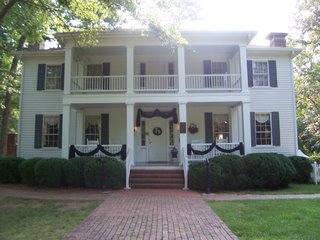
Every year Romance Writer's of America holds a national conference for its 9500 members. It includes workshops, agent/editor appointments, and an award ceremony. The Powers That Be change the location every year in an effort to accomodate those members who live in various sections of the country. This year, this past week actually, the conference was held in Atlanta Georgia. I managed to scrounge up the money to attend and gleefully stayed an extra couple of days to play--I mean research. One of the places I visited was Stately Oaks Plantation in Jonesboro.
http://www.georgianationalfair.com/RESULTS/WebDesignContestWinners/StatelyOaks/history.htm
Imagine my excitement when I found out I had come on the first day of a full month long display/tour of Victorian Mourning! My book Wicked Widow (shameless plug there!) is about a woman who breaks the rules and doesn't go into mourning when her first, and second, and third, husbands die, so this was right up my alley.
Anway, you'll see in the picture above that Stately Oaks is draped in black and has a wreathe on the door to tell the outside world that someone living in the house had died. In this particular case they were re-enacting the actual death of a child. Although they refused to allow me to take pictures inside the house--or a tape recorder--I did manage to jot down a few notes to share with others obsessed, or even mildly interested, in the Victorian period.
1.) The bottom floor (no one went upstairs so that didn't matter) was draped in black. This included musical instruments and mirrors.
2.) The casket was laid originally in the parlor. For a child's death a white rose (symbolizing innocence) was laid on top, with its stem broken, for the broken hearts of all those who'd lost someone so young.
3.) The parlor windows where the body was laid were draped in black.
4.) According to the tour guide, women went into mourning for 2 1/2 years. I have a book that contradicts that (Confidence Men and Painted Women by Karen Halttunen) with a 2 year period for widows. Regardless, during the first year a woman wore strictly black, from her shoes, to her hat, to her gloves and fan. After the first year she went into "second" or "lighter" mourning, gradually replacing various parts of her wardrobe with gray, violet or white.
Men wore black bands on their arms. That was all they were required to do.
5.) People brought food to the mourning family back then as they do today.
Those are the only notes I managed to jot down. The guide told me much, much more, but I couldn't remember it all, so I'll see what I can do later to write a little more about mourning rituals in Victorian America. Of course, much of this was already covered in Nicole's previous blog:
http://somethingvictorianblog.blogspot.com/2006/04/mourning-rituals-and-customs.html.









1 comment:
Dee,
I love the Blog. You made Stately Oaks accessible to all of us stay-at-homers. Plus, I learned more details about Victorian mourning.
Thanks for sharing this with us!
PS: The photo is gorgeous. You must have a very fine camera - and a good eye!
Mary Ann
Post a Comment